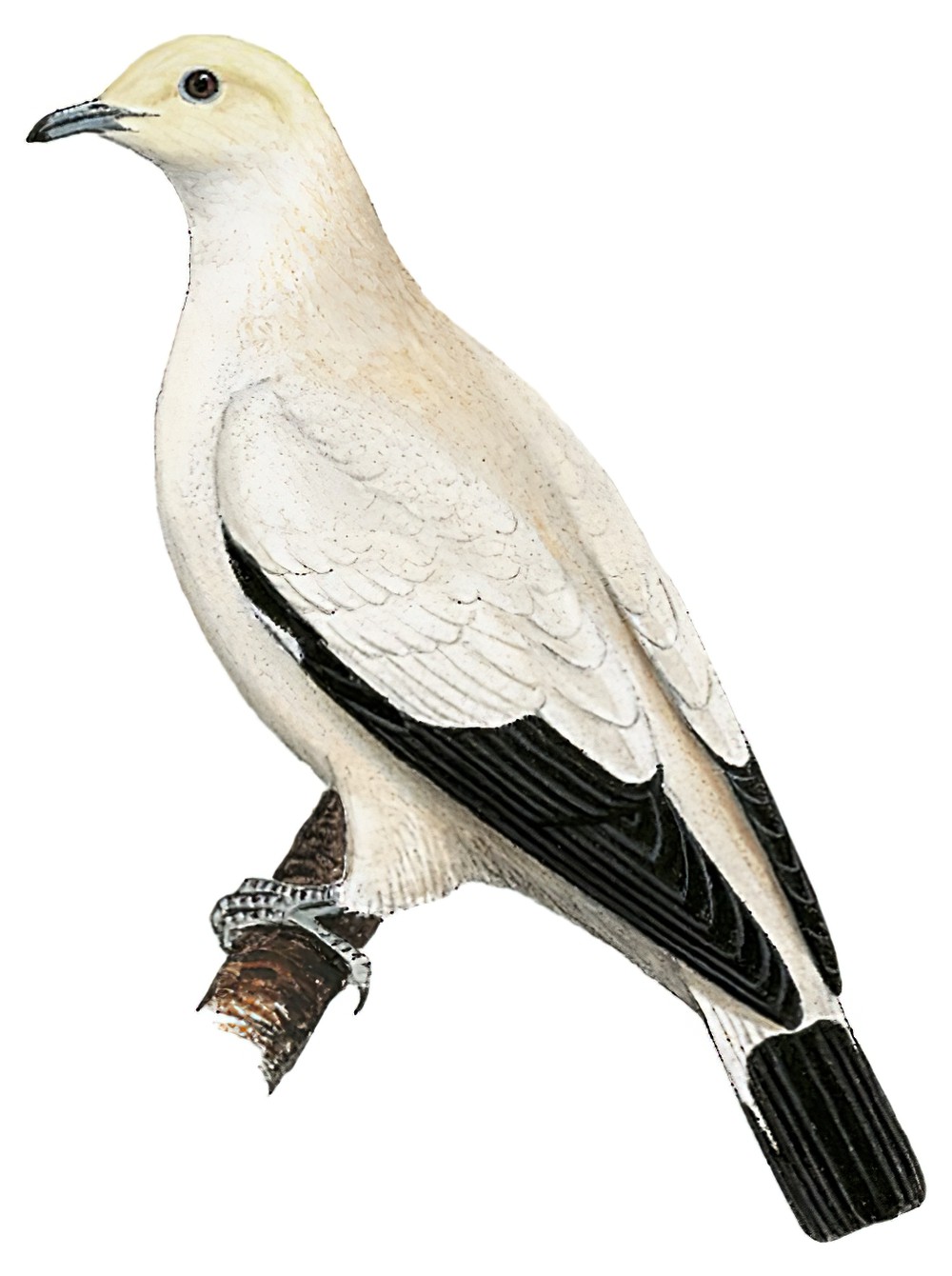Pied Imperial-Pigeon / Ducula bicolor

Pied Imperial-Pigeon
SCI Name:
Protonym: Columba bicolor Del.Flor.Faun.Insubr. 2 p.94
Taxonomy: Columbiformes / Columbidae / Ducula
Taxonomy Code: piipig1
Type Locality: 'Nova Guiana'' i. e. New Guinea.
Author: Scopoli
Publish Year: 1786
IUCN Status: Least Concern
DEFINITIONS
DUCULA
(Columbidae; Ϯ Mountain Imperial Pigeon D. badia insignis) Nepalese name Dukul for the imperial pigeons (cf. Hindi names Dunkul and Doomkul); "Genus or Sub-genus — DUCULA nobis. — DUKUL OF THE NIPALESE (genericé) Character of the genus:—bill equal to the head, straight, cylindric, very feeble; both mandibles membranous for three-fourths from the gape; tip of the upper mandible gently inclined—of the lower, strongly compressed; nares broad, linear, obliquely transverse, central; their groove faint; their tect subtumid. Wings short, not rounded, 3, 4, 5 quills sub-equal and longest; central primaries with their tips wavily truncated. Tail 14, long, strong and square; tarsi very low, and plumed nearly to the toes laterally, less in front; toes depressed with broad flat soles; lateral fores sub-equal, hind large; nails strong, arched and acuminated; central and hind equal, lateral fores equal, less; orbits nude; plumage simple. The above is a tedious charcater, but it is a distinct one. Those who love more summary proceedings may perhaps approve the following: "Bill and wings as in Goura; legs and feet as in Vinago." ... Lastly, though Ducula, like Vinago, be exclusively arboreal and fruit-eating; the latter is eminently gregarious—the former, almost a solitary. Species new. DUCULA INSIGNIS. Great Ducula, nobis." (Hodgson 1836); "Ducula Hodgson, As. Res., 19, 1836, p. 160. Type, by monotypy, Ducula insignis Hodgson." (Peters, 1937, III, p. 42).
Synon. Carpophaga, Carpophagella, Compsoenas, Globicera, Lamprura, Muscadivora, Muscadivores, Myriphaga, Myristicivora, Phaenorhina, Pterocolpa, Ptilocolpa, Rinopus, Serresius, Zonoenas, Zonophaps.
bicolor
L. bicolor, bicoloris bicoloured < bi- two- < bis twice; color, coloris colour; epithet usually given to spp. with white underparts and contrastingly darker upperparts.
● ex “Crested Titmouse” of Catesby 1731, and “Mésange hupée de la Caroline” of Brisson 1760 (Baeolophus).
● ex “Coucal Noirou” of Levaillant 1807, pl. 220 (syn. Centropus nigrorufus).
● ex “Colibri Nr. 2” of Fermin 1769, “Saphir-émeraude” of de Buffon 1770-1783, and “Sapphire-and-Emerald Humming-bird” of Latham 1782 (Cyanophaia).
● ex “Pic varié de la Encénade” of d’Aubenton 1765-1781, pl. 748, fig.1, and “Encenada Woodpecker” of Latham 1782 (syn. Dendrocopos lignarius).
● ex “Pato roxo y negro” of de Azara 1802-1805, no. 436 (Dendrocygna).
● ex “Ramier blanc mangeur de muscade de la Nouvelle Guinée” of Sonnerat 1776 (Ducula).
● ex “Gobe-mouche à ventre blanc de Cayenne” of d’Aubenton 1765-1781, pl. 566, fig. 3, and de Buffon 1770-1786, and “Black and white Fly-catcher” of Edwards 1758, and Latham 1783 (syn. Fluvicola pica).
● ex "Merle brun du Cap de Bonne Espérance" of de Buffon 1770-1783, and "White-rumped Thrush" of Latham 1783 (Lamprotornis).
● ex "Bahama Sparrow" of Catesby 1731 (Melanospiza).
● ex “Petit Guêpier du Sénégal” of d’Aubenton 1765-1781, pl. 318 (?syn. Merops hirundineus).
● ex “Guêpier de l’isle de France” of d’Aubenton 1765-1781, pl. 252 (syn. Merops viridis).
● ex “Schet Noir” of Levaillant 1805, pl. 148 (syn. Terpsiphone mutata).
SUBSPECIES
Pied Imperial-Pigeon (bicolor)
SCI Name: Ducula bicolor bicolor
bicolor
L. bicolor, bicoloris bicoloured < bi- two- < bis twice; color, coloris colour; epithet usually given to spp. with white underparts and contrastingly darker upperparts.
● ex “Crested Titmouse” of Catesby 1731, and “Mésange hupée de la Caroline” of Brisson 1760 (Baeolophus).
● ex “Coucal Noirou” of Levaillant 1807, pl. 220 (syn. Centropus nigrorufus).
● ex “Colibri Nr. 2” of Fermin 1769, “Saphir-émeraude” of de Buffon 1770-1783, and “Sapphire-and-Emerald Humming-bird” of Latham 1782 (Cyanophaia).
● ex “Pic varié de la Encénade” of d’Aubenton 1765-1781, pl. 748, fig.1, and “Encenada Woodpecker” of Latham 1782 (syn. Dendrocopos lignarius).
● ex “Pato roxo y negro” of de Azara 1802-1805, no. 436 (Dendrocygna).
● ex “Ramier blanc mangeur de muscade de la Nouvelle Guinée” of Sonnerat 1776 (Ducula).
● ex “Gobe-mouche à ventre blanc de Cayenne” of d’Aubenton 1765-1781, pl. 566, fig. 3, and de Buffon 1770-1786, and “Black and white Fly-catcher” of Edwards 1758, and Latham 1783 (syn. Fluvicola pica).
● ex "Merle brun du Cap de Bonne Espérance" of de Buffon 1770-1783, and "White-rumped Thrush" of Latham 1783 (Lamprotornis).
● ex "Bahama Sparrow" of Catesby 1731 (Melanospiza).
● ex “Petit Guêpier du Sénégal” of d’Aubenton 1765-1781, pl. 318 (?syn. Merops hirundineus).
● ex “Guêpier de l’isle de France” of d’Aubenton 1765-1781, pl. 252 (syn. Merops viridis).
● ex “Schet Noir” of Levaillant 1805, pl. 148 (syn. Terpsiphone mutata).
Pied Imperial-Pigeon (melanura)
SCI Name: Ducula bicolor melanura
melanura
Gr. μελανουρος melanouros with a black tail < μελας melas, μελανος melanos black; -ουρος -ouros -tailed < ουρα oura tail.
● ex “Cinereous Fulmar” of Latham 1785 (syn. Adamastor cinerea).
● ex “Mocking Creeper” of Latham 1782 (Anthornis).
● ex “Gros-bec de la Chine” of Sonnerat 1782, and “Grey-necked Grosbeak” of Latham 1783 (syn. Eophona migratoria).
UPPERCASE: current genus
Uppercase first letter: generic synonym
● and ● See: generic homonyms
lowercase: species and subspecies
●: early names, variants, mispellings
‡: extinct
†: type species
Gr.: ancient Greek
L.: Latin
<: derived from
syn: synonym of
/: separates historical and modern geographic names
ex: based on
TL: type locality
OD: original diagnosis (genus) or original description (species)












